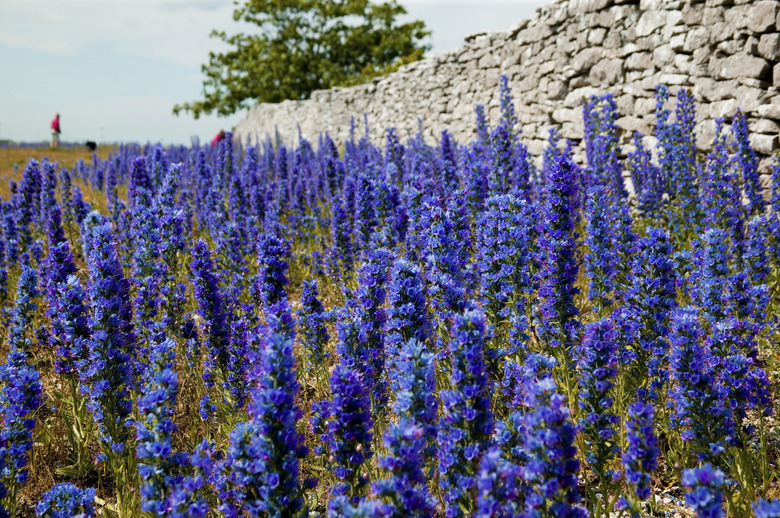How To Propagate Echium
Varying from 16-inch bedding plants to stately spires 10 feet tall, echiums (Echium spp.) generally are hardy biennials or tender perennials with rosettes of hairy leaves and bell-shaped blue, purple, white, pink or red flowers clustered up the stems. Because echiums prefer dry, poor soil in full sun, they can thrive in areas that would bake other plants. Their hardiness varies from U.S. Department of Agriculture plant hardiness zones 3 to 11. Often known as buglosses, echiums are toxic and their hairy leaves may irritate the skin.
Gather Echium Seeds
Unlike most seeds, those of echium are "naked," meaning that they are formed inside the calyx — usually four to a calyx — rather than in a closed seed pod. (The calyx is the five bristly small leaves, called sepals, which cup each bloom.) Because there won't be browning pods to inform you that the seeds are ripe, you will need to keep a close eye on those seeds, which are roughly triangular, gray, brown or black, and about 1/10-inch long. Once you see that a few are beginning to fall, wear gloves while gathering the others, to protect your skin from the plant's bristles. Spread the seeds on paper towels for several days to make sure they are dry before storing them in paper seed or coin envelopes.
Sow Echium Seeds
To grow hardy biennial echiums such as viper's bugloss (Echium vulgare, USDA zones 3 to 11) in mild climates, sow the seeds directly into the ground outdoors in fall. Plant them when daytime temperatures are in the 60 to 65 degrees Fahrenheit range, covering them with 1/4 inch of soil. After the seedlings have emerged in three weeks to four months, thin them to stand 18 inches apart. In colder climates or for tender perennial echiums, sow the seeds indoors in early spring eight to 10 weeks before your last spring frost date. Fill a pot to within 1 inch of its rim with a damp mix of one part seed starting mix and one part sand. After scattering the seeds over the surface of the mix, cover them with 1/4 inch of damp sand. Place the pot in a greenhouse or under grow-lights where temperatures remain between 60 and 65 degrees Fahrenheit. If the soil mix is kept lightly damp, the seeds should begin sprouting within one to three weeks.
Root Echium Cuttings
To start echiums from cuttings, wear heavy rubber gloves to take 3-inch greenwood (softwood) cuttings from the tips of shoots in spring or early summer or semi-hardwood cuttings in late summer. Harvest those cuttings either in the early morning or late afternoon, severing each one just below a leaf node and dipping your pruning shears in a mix of 9 parts water and 1 part bleach between cuts to disinfect them. After filling a pot with a mix of one part peat moss to one part sand, mix up a rooting solution, using one part liquid rooting concentrate to 20 parts of water for softwood cuttings or 10 parts of water for semi-hardwood cuttings. Snip off each cutting's lower leaves, leaving only a couple at the tip, and trim the remaining leaves back by half if they are large ones. Dunk the base of the cutting 1 inch deep in the rooting hormone solution for 3 to 5 seconds. Afterward, insert that base into the mix and tamp the mix tightly around it. Cover the pot only loosely with an inverted plastic bag which doesn't touch the cuttings, as echiums don't like overly moist conditions. If necessary, you can insert plastic drinking straws around the edge of the pot to hold the bag away from the cuttings. After placing the pot in an area with bright light but no direct sun, make sure that the soil remains lightly damp with temperatures in the 70s Fahrenheit. Don't disturb the cuttings for several weeks until new growth indicates that they have rooted.
Avoid Echium Over-Propagation
Some buglosses and their cultivars can be invasive. Purple viper's bugloss (Echium plantagineum, USDA zones 3 to 8) is, in fact, often called Paterson's Curse. Even less hardy echiums, such as Pride of Madeira (Echium candicans, USDA zones 9 through 10), produce a large number of seeds. If you wish to control their self-seeding, don't forget to prune off stalks of faded flowers before they make pods.
References
- American Horticultural Society Encyclopedia of Plants and Flowers; Christopher Brickell
- Seeds: The Ultimate Guide to Growing Successfully from Seed; Jekka McVicar
- Taylor's Guide to Annuals; Barbara W. Ellis
- Making More Plants: The Science, Art, and Joy of Propagation; Ken Druse
- University of California: General Information on Propagation by Stem Cuttings
- Oregon State University Extension Service: Paterson's Curse
- The United States National Arboretum: This Is Viper's Bugloss, Echium vulgare
- Outside Pride: Echium Seeds
- The New Sunset Western Garden Book; Kathleen Norris Brenzel, Editor
- The Plant Book; Susan Page and Margaret Olds, Editors
